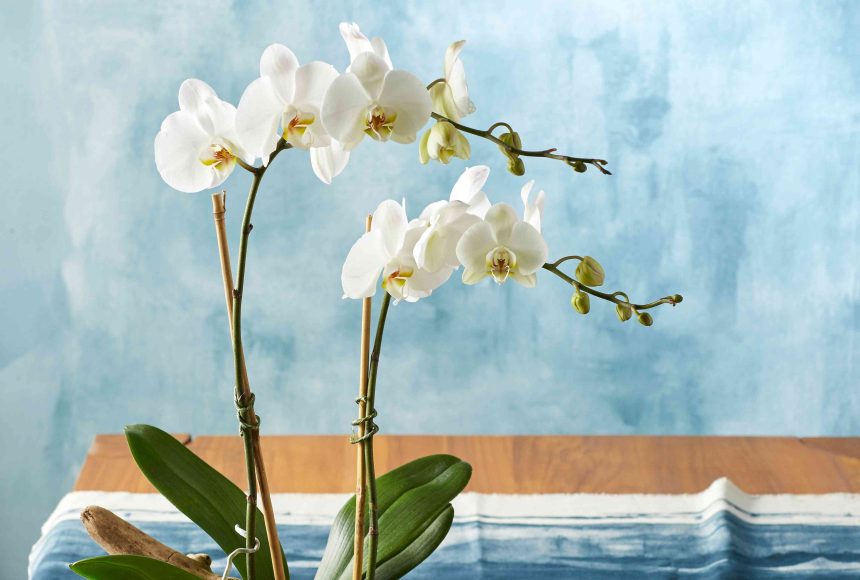You bought your orchid when it was loaded with flowers and admired its gorgeous blooms for months. Now, the flowers have dropped off, and you’re wondering what to do with the remaining ho-hum clump of leaves. Should you keep it? Is it even alive? Will it ever bloom again? We asked an orchid expert for the answers.
“Yes, you can get an orchid to bloom again if you set it up for success,” says Justin Kondrat, lead horticulturist at the Smithsonian Gardens Orchid Collection. Once the orchid finishes blooming, it isn’t dead or dying, he explains. It just “needs time to recharge.”
So instead of throwing it out, help your plant stay healthy and bloom again for years to come with these tips on orchid care after blooming. This guide focuses specifically on moth orchid care because it’s a popular pick for beginners and is widely available.
Orchid Care After Flowering
Orchids are long-lived plants that produce flowers every year in the late winter if they receive the proper care. “After an orchid flowers, it’s tired, and it needs to rest and recover so it can flower again,” Kondrat says. “It has a rhythm, and you just have to get in sync with the rhythm of your orchid.”
If you know what you are doing, you can get a moth orchid to bloom multiple times a year, he says. Here are Kondrat’s top tips for helping your orchid thrive so it will keep on blooming for you.
1. Repot the Orchid
Once your orchid is done blooming, repot it. “I recommend repotting an orchid every two years,” Kondrat says. If your orchid came from the store potted in sphagnum moss, Kondrat recommends repotting it in a chunky potting mix labeled for orchids as soon as it is done blooming. “Get it out of that moss. It holds a lot of water and can cause root rot,” he says. A chunky potting medium allows better drainage so conditions don’t stay overly soggy.
2. Trim the Plant
With a pair of scissors or hand pruners, remove any yellowing leaves. Leave healthy green leaves on the plant so they can make food. “Those leaves are the orchid’s solar panels,” Kondrat says. “They make energy for the plant to recharge it.”
Trim the flower spike, too, in one of two ways:
- Cut it off completely, and the plant will bloom again in several months when a new spike grows.
- Cut the spike two or three nodes below the lowest flower, and the orchid may bloom again in as soon as 8 to 12 weeks. “There’s a 50% chance a new stalk will grow from the old one,” Kondrat says. “You’ll get flowers faster this way.”
3. Fertilize the Orchid
Feed your orchid in early spring or late winter. That’s when the plant is preparing to put on new growth and new blooms, so it needs a good meal. Kondrat recommends using a fertilizer formulated for orchids, diluted to 25% of the strength recommended on the label.
Fertilize every other week during the plant’s growing season between March and October. Don’t overfertilize, or you can damage the orchid by burning its root tips, Kondrat says. Don’t fertilize over the winter when it’s growing more slowly.
Give your orchid a boost by spritzing its leaves with a mixture of 2 tablespoons of Epsom salts to a gallon of water. “The magnesium and calcium work together to enhance the production of chlorophyll. It’s like a vitamin for your plant,” Kondrat says.
4. Water the Plant Consistently
Many people overwater an orchid and drown its roots, killing it. Kondrat recommends watering an orchid every 7 to 10 days when it’s potted in orchid mix. Orchids potted in moss need less frequent watering because the moss retains water longer.
Kondrat says there are no hard and fast rules about when to water an orchid. Factors like light and temperature affect how often the plant needs water. “It’s one of those things you’re going to have to observe your plant to pin down exactly when it needs water,” he says. Poke your pointer finger in the orchid’s moss or bark potting medium. If feels dry, give it water. Let the orchid’s potting medium dry out between waterings.
5. Skip the Ice Cubes, Please
Forget what you’ve heard about using an ice cube to water an orchid. Sure, it’s cute marketing, but it’s an imprecise way to water, and the cold shock can damage this tropical plant’s roots. Use water at room temperature and give your plant a good soak by putting it under the tap and keeping it there for about 10 seconds until water runs out the bottom of the plant, Kondrat says. “The water will diffuse through the root system of the orchid and rinse away any residual salts from fertilizer.”
6. Give Your Orchid the Right Light
Orchids like bright but indirect light and temperatures between 70°F and 90°F. Kondrat says to put your orchid by an east window if possible, but south and west may also be OK. Again, you need to pay attention to the plant.
“If you are comfortable sitting in a chair by that window, your orchid will be comfortable in that environment, too. If it’s too hot for you, it’s probably too hot for the orchid,” Kondrat says. Look at the plant’s leaves to determine if the light is right.
If the leaves are dark green, the orchid isn’t getting enough light. A red tinge on the leaves means the plant is getting too much light. “Leaves should be yellow-green or olive green,” Kondrat says.






